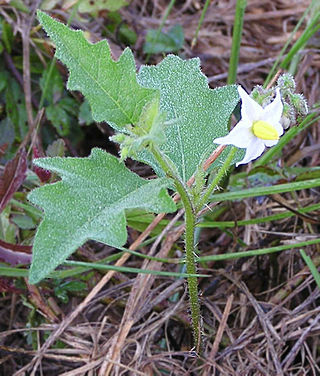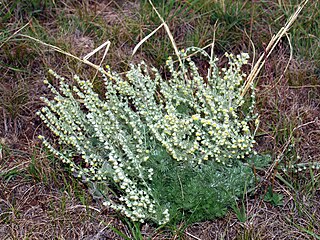
Ficaria verna, commonly known as lesser celandine or pilewort, is a low-growing, hairless perennial flowering plant in the buttercup family Ranunculaceae native to Europe and Western Asia. It has fleshy dark green, heart-shaped leaves and distinctive flowers with bright yellow, glossy petals. It is now introduced in North America, where it is known by the common name fig buttercup and considered an invasive species. The plant is poisonous if ingested raw and potentially fatal to grazing animals and livestock such as horses, cattle, and sheep. For these reasons, several US states have banned the plant or listed it as a noxious weed. It prefers bare, damp ground and is considered by horticulturalists in the United Kingdom as a persistent garden weed; nevertheless, many specialist plantsmen, nursery owners and discerning gardeners in the UK and Europe collect selected cultivars of the plant, including bronze-leaved and double-flowered ones. Emerging in late winter with flowers appearing late February through May in the UK, its appearance across the landscape is regarded by many as a harbinger of spring.

Solanum carolinense, the Carolina horsenettle, is not a true nettle, but a member of the Solanaceae, or nightshade family. It is a perennial herbaceous plant, native to the southeastern United States, though its range has expanded throughout much of temperate North America. The plant is an invasive in parts of Europe, Asia, and Australia. The stem and undersides of larger leaf veins are covered with prickles.

Chlorogalum pomeridianum, the wavy-leafed soap plant, California soaproot, or Amole, is the most common and most widely distributed of the soap plants, soaproots or amoles, which make up the genus Chlorogalum of flowering plants. It is occasionally known as the "wild potato", but given the plant's lack of either resemblance or relationship to the potato, this name is not recommended.

Verbascum thapsus, the great mullein, greater mullein or common mullein, is a species of mullein native to Europe, northern Africa, and Asia, and introduced in the Americas and Australia.

Aesculus californica, commonly known as the California buckeye or California horse-chestnut, is a species of buckeye native to California and southwestern Oregon.

Calocedrus decurrens, with the common names incense cedar and California incense cedar, is a species of coniferous tree native to western North America. It is the most widely known species in the genus, and is often simply called incense cedar without the regional qualifier.

Viola sororia, known commonly as the common blue violet, is a short-stemmed herbaceous perennial plant native to eastern North America. It is known by a number of common names, including common meadow violet, purple violet, woolly blue violet, hooded violet, and wood violet.

Euphorbia lathyris, the caper spurge or paper spurge, is a species of spurge native to southern Europe, northwest Africa, and eastward through southwest Asia to western China.

Euphorbia peplus, is a species of Euphorbia, native to most of Europe, northern Africa and western Asia, where it typically grows in cultivated arable land, gardens and other disturbed land.

Codiaeum variegatum is a species of plant in the genus Codiaeum, which is a member of the family Euphorbiaceae. It was described by Carl Linnaeus in 1753. It is native to Indonesia, Malaysia, Australia, and the western Pacific Ocean islands, growing in open forests and scrub.

Rubus ursinus is a North American species of blackberry or dewberry, known by the common names California blackberry, California dewberry, Douglas berry, Pacific blackberry, Pacific dewberry and trailing blackberry.

Verbascum blattaria, the moth mullein, is a flowering biennial plant belonging to the figwort family Scrophulariaceae. A native of Eurasia and North Africa, it has naturalized in the United States and most of Canada since its introduction and has become an invasive species there. It has been declared a noxious weed by the state of Colorado.
Fish toxins or fish stupefying plants have historically been used by many hunter gatherer cultures to stun fish, so they become easy to collect by hand. Some of these toxins paralyse fish, which can then be easily collected. The process of documenting many fish toxins and their use is ongoing, with interest in potential uses from medicine, agriculture, and industry.

Conium maculatum, colloquially known as hemlock, poison hemlock or wild hemlock, is a highly poisonous biennial herbaceous flowering plant in the carrot family Apiaceae, native to Europe and North Africa. A hardy plant capable of living in a variety of environments, hemlock is widely naturalized in locations outside its native range, such as parts of Australia, West Asia, and North and South America, to which it has been introduced. It is capable of spreading and thereby becoming an invasive weed.

Lilium occidentale is a rare North American species of lily known by the common name western lily. Its species name 'Occidentale' means 'westernmost' and refers to its location along the West Coast. It is native to northwestern California and southwestern Oregon. It grows in coastal prairie habitat, swamps and stagnant bogs with Drosera species, bluffs and sandy cliffs, and seaside spruce forests. This rare wildflower is limited in distribution and directly endangered by a number of environmental factors. It is a federally listed endangered species and it is listed as endangered by the states of California and Oregon.

Sambucus cerulea or Sambucus nigra ssp. cerulea, with the common names blue elderberry and blue elder, is a coarse textured shrub species of elder in the family Adoxaceae.

Artemisia frigida is a widespread species of flowering plant in the aster family, which is known as the sunflower family. It is native to Europe, Asia, and much of North America. In parts of the north-central and northeastern United States it is an introduced species.

Bassia hyssopifolia is a species of flowering plant in the family Amaranthaceae, known by the common names five-horn smotherweed, five-hook bassia, and thorn orache. It is native to parts of Asia and Eastern Europe, and it is known on other continents as an introduced species, including North and South America and Australia. It is a weed, invasive at times.

Croton monanthogynus is a species of flowering plant in the spurge family. The undersides are gray. It is a summer annual that produces small, inconspicuous flowers. The plant is monoecious and has both male and female reproductive organs in separate clusters on the same plant. Its leaves are alternate. It is native to the southeastern United States and the southern Great Plains. It is considered adventive in more northern states. AL, AR, AZ, GA, IA, IL, IN, KS, KY, LA, MD, MI, MO, MS, NC, NE, OH, OK, PA, SC, TN, TX, VA, WI, WV.
Croton macrostachyus is a species of flowering plant native to the mountains of Sub-Saharan Africa.



















